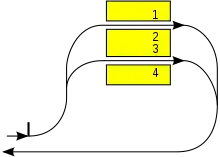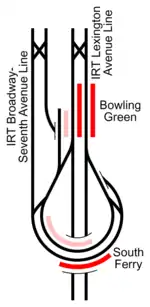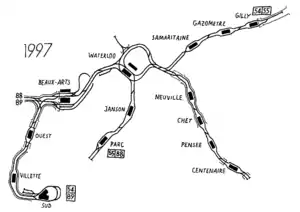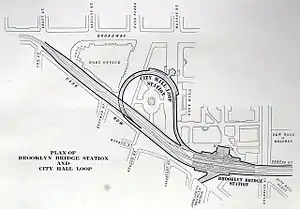Balloon loop
A balloon loop, turning loop or reversing loop (North American) allows a rail vehicle or train to reverse direction without having to shunt or even stop. Balloon loops can be useful for passenger trains and unit freight trains such as coal trains.


P1 & P4 departures
P2 & P3 arrivals

Balloon loops are common on tram or streetcar systems. Many streetcar and tram systems use single-ended vehicles that have doors on only one side and controls at only one end, or they haul trailers with no controls in the rear car and so must be turned at each end of the route.
History
Balloon loops were first introduced on tram and, later, metro lines. They did not commonly appear on freight railways until the 1960s, when the modernising British Rail system introduced merry-go-round (MGR) coal trains that operated from mines to power stations and back again without shunting.
Tramways
Balloon loops enable higher line capacity (faster turnaround of a larger number of trams) and allow the use of single-ended trams which have several advantages, including lower cost and more seating when doors are on one side only. However, double-ended trams also benefit from the capacity advantage of balloon loops, for example on the former Sydney tram system where loops were used from 1881 until the second-generation system's closure in 1961. Initially the Sydney system was operated by single-ended steam trams and then, from the 1890s, by double-ended electric trams. Lines were looped in the Sydney CBD and the other busiest areas of operation, such as the eastern suburbs lines, as they provided greater turn-around capacity on this very busy system. The Sydney system was the first example of a tramway system using loops and has continued to build them up to 1997 (third-generation system).
Later in the 19th century, looped streetcar (tram) lines also began to appear on systems in the US and soon looped operation with single-ended streetcars became widely used on many North American streetcar systems. European systems were almost universally converted to looped operation in the early 20th century, and most also adopted single-ended trams. Loops were also used on some tramways in Asia, South America and New Zealand, as well as on some other Australian systems in addition to Sydney. Looped operation with single-ended trams is still the predominant method of tramway operation in the world, in spite of the recent construction of some new, typically smaller, stubbed systems with double-ended trams.
Examples
Passenger

On a balloon loop, the station is on the balloon loop, and the platform may be either curved or straight.
Australia
- Penfield - now closed and removed
- Outer Harbor - now closed and removed
- Olympic Park, Sydney, Australia: platforms 1 and 4 are for boarding, 2 and 3 for alighting.
- Beech Forest railway station, Victoria, Australia: single platform station on Victorian narrow gauge railway - now closed and removed.
- City Loop, Melbourne, Australia: Effectively four balloon loops with five stations: Flinders Street, Southern Cross, Flagstaff, Melbourne Central and Parliament
Austria
The tram systems in Vienna, Graz, Linz and Innsbruck employ Balloon Loops
Canada
France (Paris Métro)
- Non-passenger loops: Porte Dauphine (line 2), Porte des Lilas (line 3bis), Porte de Clignancourt and Porte d'Orléans (line 4)
- Passenger loops: Nation (line 2), Charles de Gaulle – Étoile and Nation (line 6), Pré Saint-Gervais (line 7bis)
- The western end of line 10 is a long loop: trains arriving at Mirabeau from Gare d'Austerlitz used to enter a loop with the following stations, Église d'Auteuil, Auteuil, Porte d'Auteuil (official terminus), Michel-Ange – Molitor, Chardon Lagache and Mirabeau again, to continue eastwards.
- There also are a few loops used for stabling trains, such as west of Invalides and north of Porte de la Villette.
United Kingdom
Simplified rail network around Newcastle | ||||||||||||||||||||||||||||||||||||||||||||||||||||||||||||||||||||||||||||||||||||||||||||||||||
|---|---|---|---|---|---|---|---|---|---|---|---|---|---|---|---|---|---|---|---|---|---|---|---|---|---|---|---|---|---|---|---|---|---|---|---|---|---|---|---|---|---|---|---|---|---|---|---|---|---|---|---|---|---|---|---|---|---|---|---|---|---|---|---|---|---|---|---|---|---|---|---|---|---|---|---|---|---|---|---|---|---|---|---|---|---|---|---|---|---|---|---|---|---|---|---|---|---|---|
| ||||||||||||||||||||||||||||||||||||||||||||||||||||||||||||||||||||||||||||||||||||||||||||||||||
- Dungeness, Romney, Hythe and Dymchurch Railway, Kent, England: single track, single platform for both boarding and alighting.[1]
- Merseyrail, the Wirral Line underground loop under Liverpool, England (3 stations on loop)
- Ruislip Lido Railway, a miniature railway in West London, England
- The Eurotunnel Shuttle uses balloon loops: since the two tracks cross over at the French end the whole line forms a figure 8 loop. This evens the wear on the train wheels.
- Central station in Newcastle upon Tyne is on a loop, allowing trains from the South to arrive via the King Edward VII Bridge and return using the High Level Bridge.
- Peasholm on the North Bay Railway in Scarborough, North Yorkshire has a reverse balloon loop, with the "neck" of the balloon facing the buffer stop. The loop is used to allow the locomotive to run round the train and reverse at the same time.
- The first Wembley Stadium station in London (opened 1923, closed 1968) was on a balloon loop, but the present station of that name is not.
- Barmouth Ferry station on the Fairbourne Railway until closure due to sand movements on the loop made the loop unprofitable however the track still exists.
- Blackpool Tramway has a balloon loop at each end of the system (Starr Gate and Fleetwood) and at two intermediate points.
- The Charing Cross, Euston and Hampstead Railway (now known as the London Underground's Northern line) constructed a single track balloon loop curving underneath the River Thames to serve its southern terminus of Embankment tube station, When the line was extended southwards to Morden in 1926, the loop was sealed off.
- Kennington station, also on the Northern line, has a balloon loop to the south of the station to allow terminating southbound trains to reach the northbound platforms to form a return service.
- The Piccadilly line has a single track balloon loop (T4 loop) under Heathrow Airport connecting in order Hatton Cross tube station, Heathrow Terminal 4 tube station, Heathrow Terminals 1, 2, 3 tube station and back to Hatton Cross tube station.
United States
- Newark City Subway at Penn Station and Hudson Bergen Light Rail at North Bergen in New Jersey
- Paulsboro Marine Terminal, planned loop for dockside access[2]
- Formerly, the St. Louis streetcar system had several loop stations, which have left their names in city landmarks. These include the Hampton, Catalan, Wellston,[3] and Delmar Loops. Although Delmar Boulevard now has a trolley route, it no longer features a balloon loop at either end.
- Boston:
- Bowdoin Station on the MBTA Blue Line in Boston has a wedge-shaped island platform inside a balloon loop. The boarding platform is long enough for only four cars, but all of the trains on the line are six cars so only the rear four can be boarded at Bowdoin.
- The MBTA Green Line, in Boston and suburbs, has balloon loops at several major stations. The loop at its Lechmere station operated from 1922 until 2020, when it was closed as part of extending the line.
- Mattapan Station on the MBTA Ashmont–Mattapan High Speed Line in Boston, has trolley cars unload passengers at the platform, then uses a balloon loop to return to the same platform to load inbound passengers.
- California
- Union Pacific Railroad at Truckee, California - loop to avoid needing to reverse rotary snow plows[4]
- Judah and La Playa station is a balloon track that serves as the western terminus of the San Francisco Municipal Railway N Judah line.
- Wawona and 46th Avenue station is a balloon track that serves as the western terminus of the San Francisco Municipal Railway L Taraval line.
- The two terminal stations of North Hollywood Station and Chatsworth Station for the G Line Metro Bus Transit of Los Angeles, California have their platforms on a balloon loop.


- New York City:
- City Hall subway station on the IRT Lexington Avenue Line in New York City is now closed, although the loop track continues to be used to turn local trains. These trains discharge and take on passengers at Brooklyn Bridge – City Hall, one station to the north.
- South Ferry (see diagram) was a two-track subway loop station in New York City, with a sharply curved side platform for each track. Due to problems with train length and platform clearance, this station was replaced by a standard stub terminus with two tracks and an island platform (South Ferry), although the original trackage remains in use for turning trains. After the latter station was damaged in Hurricane Sandy, the former station was reopened temporarily to provide service to the ferry terminal until the repairs to the latter station were completed.[5]
- Grand Central Terminal, New York City - stacked upper and lower level loops (lower loop has since been removed). The upper level loop track runs beyond track 38 (and a few others) to bring trains out on tracks 1, 2 (and others) on the East side Northbound.
- World Trade Center station on the PATH subway system linking New York and New Jersey.
- Philadelphia:
- 13th Street (formerly Juniper Street) is the eastern terminus for the SEPTA Subway-Surface Lines in Philadelphia, and trolleys turn on a balloon loop around Philadelphia City Hall
- Fern Rock is the northern terminus for the Broad Street Line in Philadelphia, and rapid transit trains use a double-track balloon loop for turning & staging.
- Frankford and Delaware Avenue station, also known as the Northern Liberties Loop, "temporary terminus" of the Girard Avenue Trolley while the Richmond-Westmoreland Streets Loop remains out of service.
Other
- Various stations of the Hong Kong Tramways and MTR Light Rail
- In the Charleroi Pre-metro, both the Beaux-Arts and Waterloo stations have balloon loops. At Beaux-arts, trains between Sud and Anderlues (line 89, both directions) first run through the station on a platformless track, take the underground balloon loop then stop at the platform leading to their destination. Waterloo station services three lines (54, 55 and 88) going to three directions, on a single island platform. Trains from Gilly station either diverge to the right and end up at the station to continue to Parc station, or diverge to the left to end up on the other end of the island platform to go towards Beaux-Arts. At the station is also a bypass so trains can run from Gilly directly to Beaux-Arts, without halting at the platform. No scheduled trains thus fully run the loop (or the bypass).
 The Charleroi Pre-metro system features two balloon loops, at Beaux-Arts and Waterloo stations.
The Charleroi Pre-metro system features two balloon loops, at Beaux-Arts and Waterloo stations. - The Amsterdam, Rotterdam and The Hague tram systems have balloon loops at the end of all lines. Only Amsterdam line 5 terminus at Amstelveen Binnenhof[6] and The Hague lines branded as Randstadrail do not have balloon loops.
Across these cities there are several unused balloon loops that were in use until lines were extended or abolished. These loops however are still maintained for eventual purposes.
The municipality of The Hague however plans on removing them and purchase new trams with a drivers cabine on both sides of the tram. - The Saitama New Shuttle has a balloon loop at Ōmiya.
Multiple stations on a balloon loop:
- Heathrow Terminal 4 and Terminals 1,2,3 stations on the Piccadilly line of London Underground.[7]
- The LACMTA A Line has four stations on its loop through downtown Long Beach (California).
- In Liverpool, England, on the Wirral Line of the Merseyrail network, trains arriving at Liverpool through the Mersey Tunnel fork left at Mann Island Junction onto a balloon loop, before reaching James Street (platform 1); they then call at deep-level platforms at Moorfields, Liverpool Lime Street and Liverpool Central before reaching James Street again (platform 3), then rejoin the original route at Mann Island Junction and then pass back through the Mersey tunnel.[8]
- The City Loop or Melbourne Underground Rail Loop, Melbourne, Australia, has five stations. There a four loops, one from the north east and three from the south west, on two levels. The loops are bi-directional. A connection enables one of the south east loops to be used as a circle line. There are no connections between the four loops.
- In the city of Vantaa, Finland, in the Greater Helsinki area, the Kehärata or Ring Rail Line of Helsinki commuter rail built between an existing branch at Vantaankoski and the main line at Tikkurila opened on July 1, 2015. The line primarily serves the airport which was before only accessible by road, and new suburbs and working areas being built along the line. An existing stopping service to Vantaankoski station was replaced by a service which traverses the whole loop and returns to Helsinki, stopping twice on opposite sides of Pasila station. Five new stations were built, but the loop has a total of 22 stations, not counting Pasila or Helsinki. Roughly half of these stations are on the northbound and westbound mainlines, the loop line leaving them via diving junctions at Hiekkaharju and Huopalahti.
- Rapid Metro Gurgaon in India.
- Minami-Kōen, Naka Futō, and Kita Futō stations on the Port Island Line in Kōbe.
- The Yamaman Yūkarigaoka Line has three stations on its balloon loop: Joshidai, Chūgakkō, and Ino.
- In Singapore, the Bukit Panjang LRT line has 7 stations from Petir to Senja on a bidirectional balloon loop emerging from Bukit Panjang station, with alternate trains plying each direction of the loop.
With balloon loop: The balloon loop is past the station.

- Bad Herrenalb, Albtalbahn, Germany: the train passes the loop before arrival
- Bowling Green on New York City's IRT Lexington Avenue subway line is the southern terminus for 5 service in the evenings & on weekends, with the South Ferry inner loop (see previous section) used to turn trains.
- Brooklyn Bridge – City Hall, also on New York City's IRT Lexington Avenue Line, is the southern terminus for Lexington Avenue local service (the 6 and <6> trains), with the City Hall loop (see previous section) used to turn trains.
- Howard Station on the CTA Red Line in Chicago uses a balloon loop to turn a northbound train back south. Because the other end of the line does not contain a loop, the wear on the wheels is evened out after two trips.
- The Irish Steam Preservation Society's line at Stradbally, Co.Laois, Ireland consists of a balloon loop: trains operate from the station and back again via the loop.
- 69th Street Terminal, the western terminus of the SEPTA Market–Frankford Line in Philadelphia: westbound trains discharge passengers at the platform and go around the loop to one of two eastbound platforms to pick up passengers.
- Gateway Center in Pittsburgh used to be the north/west end of the Pittsburgh Light Rail line. Westbound trains would discharge passengers at the inbound platform, then go around a loop to the outbound platform to pick up passengers. When the subway was extended in 2009-2012, the loop was removed; while the original outbound platform under Liberty Ave was left intact, the inbound platform was demolished and moved.
- Kennington tube station, on the London Underground's Northern line: trains from the Charing Cross branch can terminate at Kennington and then run around a loop to return north. Trains from the Bank branch cannot use this loop.
- Schwabstraße station on the Stuttgart S-Bahn: the loop is south of the station and completely underground
- Tonnelle Avenue (HBLR station): the loop is to the west of the station.
Tram Systems
Balloon loops are used extensively on tramway systems with single-ended trams. Usually located at termini, the loop may be a single one-way track round a block. Single-ended trams have a cab at only one end and doors on one side, making them cheaper and having more space for passengers. On tram systems with double-ended trams balloon loops are not required but may still be used as they can provide greater turn-around capacity than a stub terminus; the Birmingham Corporation Tramways terminus at Rednal had a balloon loop in addition to the conventional stub tracks, providing extra capacity to handle weekend and bank holiday crowds visiting the nearby Lickey Hills. The Milan interurban tramway network, although using double-ended trams, had balloon loops at termini within the city limits so that they could be used as backup termini by the single directional trams used on urban service. In Milan, tramway depots are built as balloon loops, just as urban termini. Another example is in Potsdam, Germany.
Australia
- Queensland
- Port of Brisbane — Freight, dual gauge
- Pinkenba Freight and special steam services.
Loading loops
- New South Wales
- Coal
- Camberwell — Coal
- Craven — Coal
- Fassifern — Coal - has triangle as well, so trains can go north or south
- Gunnedah — Coal
- Boggabri Coal
- Maules Creek
- Boggabri Coal Terminal East
- Mount Thorley — and other mines - coal
- Newdell Junction — Coal - has two balloon loops for different coal mines
- Newnes Junction coal loader
- Tahmoor — Coal - due to change in operational requirements, the balloon loop now points the wrong way, and requires trains to be top and tailed.
- Ulan — Coal
- Wilpinyong — Coal
- Wheat
- Penny Road, near Moree — Wheat
- Queensland
- Owanilla, Maryborough South;[9] includes a circle inside the balloon to allow inspection before unloading/loading![10]
- South Australia
- Marree railway line at the Telford Cut coal mine, Leigh Creek until 2016
- Wirrida, Adelaide-Darwin Railway - iron ore[11][12]
- Mallala AWB Grain Loop
- Crystal Brook Grain Loop[13]
- Western Australia
- Koolyanobbin East (iron ore)[14]
Unloading loops
- New South Wales
- Eraring - power station
- Vales Point — power station ; Coal unloader
- Port Waratah — Coal & Wheat unloader at port
- Koorang Island — Coal unloader at port
- Port Kembla - coal and wheat
- South Australia
- Whyalla iron ore export dual gauge[15]
- Port Augusta coal power stations until 2016
- Victoria
- West Australia
Africa
- Catete, Angola
- Klipdale, South Africa, on the Overberg branch line, to allow trains from Cape Town to continue to Bredasdorp (and vice versa) without shunting.
- Port Pepel, Sierra Leone - proposed iron ore export[19]
- Dimbokro, Ivory Coast 06°38′42″N 04°42′22″W[20]
Germany
- Selke Valley Railway (German: Selketalbahn) — Part of the 1,000 mm (3 ft 3 3⁄8 in) gauge Harz Narrow Gauge Railways (German: Harzer Schmalspurbahnen). A balloon loop has been constructed at Stiege to allow freight trains between Nordhausen and the power station at Silberhütte (Harzgerode) to make their journeys without the locomotive having to run round. Passenger trains continue along the branch beyond Stiege to Hasselfelde where they reverse.
Iran
Has several balloon loops and triangles.
New Zealand
- Dargaville Branch — Balloon loop providing access to Kirikopuni, 2 km north of the main line. This was eliminated by a bypass in 1943.
- Woodville — Balloon loop linking the Wairarapa Line and the Palmerston North - Gisborne Line so that trains running between the Wairarapa and Hawke's Bay do not have to reverse. Unlike a triangle, the balloon loop enables these trains to serve Woodville station.
- Lyttelton Coal unloading rail facility.
United Kingdom
There are several balloon loops at power stations in the UK; these have been provided so that coal trains may unload without stopping (known as the merry-go-round system). Examples include Cottam, Didcot, Drax, Eggborough, Ferrybridge, and Ratcliffe-on-Soar.
Also, the Fife Circle line between Edinburgh and the county of Fife acts like a giant balloon loop, branching off after Inverkeithing and connecting again at Kirkcaldy.
Also, two London Underground lines have balloon loops; the Northern Line has one at Kennington, where trains can terminate, drive around the reversing loop, and then start again whilst others can pass through; whereas the Piccadilly Line has one serving Terminal 4 of Heathrow Airport (half of all trains use this loop to return eastwards back into London, while trains terminating at Terminal 5 must halt and reverse.
United States
- Louisa Generating Station — Coal unloader, south of Muscatine, Iowa
- National City, California — Balloon Loop near San Diego Bay
- San Francisco Transbay Terminal was a balloon loop for the Key System before it was abandoned
- Marias Pass, Montana - balloon loop on the BNSF's Northern Transcon line. It replaced a wye at the same spot.
- Donner Pass, California - there is balloon loop on either side of the pass. One is in Truckee and the other near Blue Canyon. They are primarily used to facilitate snow removal, allowing the plows and blowers to easily be returned over the pass.
Other
Both the French and the British terminals of the Eurotunnel Shuttle service through the Channel Tunnel consist of balloon loops, in opposite directions to even out wear on the wheels.
Occasionally, balloon loops are used for reversing trains on lines with heavy grades and tight curves to equalise wear on both sides of locomotives and rollingstock. Such a balloon loop was constructed at Beech Forest on the 2 ft 6 in (762 mm) Victorian Railways line from Colac to Crowes.
Advantages
Advantages of a balloon loop include:
- Smooth operation
- Trains can arrive in any free platform, while another train is leaving any platform.
- Reversal of rolling stock helps even out wear and tear on the wheels.
- Eliminates need for brake test if locomotives uncoupled to carry out run around move.
Compared to stations with stub platforms, balloon loops allow:
- Fewer tracks and platforms are required
- Arrivals into some platforms do not block departures from other platforms
- Time is not lost while drivers change ends and reset the train for the other direction
- If the driver changed ends and discovers a hidden fault, then delays to trains are less likely
Disadvantages
The major disadvantage is that a balloon loop is very space consuming. Another disadvantage is that the sharp curves cause noise, as well as wear on wheels and rails. Also, if the platform is located on the curve, the gap between the platform and railcar door is a hazard. The former South Ferry station on the New York City Subway solved this problem by using gap fillers that extended out to the railcar door when the train triggered a switch on the tracks. The older station had been closed, but was reopened as a result of damage to the newer station caused by Hurricane Sandy.
On systems where, for reasons of economy, the couplings are made non-reversible (e.g. by fitting the air brake pipe along one side of the car only), the use of a reversing loop will cause a proportion of the rolling stock to face the "wrong" way and it may not be possible to assemble a complete train in a depot, even if sufficient cars are on hand. This was the case on the Charing Cross, Euston and Hampstead Railway (now part of the Northern line of London Underground). After the opening of a loop at Charing Cross (Embankment) in 1914 (replaced in 1926 by the present Kennington loop) car ends were marked "A" or "B" (later, when axles were designated by letters, the "B" car ends became "D" to match the adjacent axle), and it was not permitted to couple cars together if the ends to be coupled bore the same letter. It was found necessary to provide a turntable at Golders Green depot (near the other end of the line), for use when there was an imbalance of car directions.[21]
To avoid this problem, on many systems with a balloon loop the couplings and brake hoses are made reversible.
At coal ports such as Kooragang in Newcastle, New South Wales the space inside the balloon loops is used for storing coal, so that it is not wasted.
At the Olympic Park station in Sydney, the loop is flattened where the platforms are located, so that the platform faces are straight.
References
- 5 Southern & TfL (Map) (3rd ed.). Railway Track Diagrams. Cartography by John Yonge. Trackmaps. November 2008. p. 18 Romney, Hythe & Dymchurch Railway. E inset. ISBN 978-0-9549866-4-3.
- "Paulsboro - The New Omniport" (video). South Jersey Port Corporation.
- "Home". The Wellston Loop. Retrieved 2019-06-16.
- "Truckee Donner Railroad Society". Archived from the original on 2012-07-11. Retrieved 2012-05-01.
- "MTA Capital Construction - South Ferry Terminal Project". web.mta.info.
- "Network plans and maps". gvb.nl.
- 5 Southern & TfL (Map) (3rd ed.). Railway Track Diagrams. Cartography by John Yonge. Trackmaps. November 2008. p. 43 Piccadilly line: South Harrow & Heathrow - Acton Town. D inset. ISBN 978-0-9549866-4-3.
- 4 Midlands & North West (Map) (2nd ed.). Railway Track Diagrams. Cartography by John Yonge. Trackmaps. March 2005. p. 40 Hunts Cross - Moorfields. ISBN 0-9549866-0-1.
- Railway Digest. October 2014. p. 14. Missing or empty
|title=(help) - "Owanilla Balloon Loop". Railpage.
- Railway Digest. February 2013. p. 54. Missing or empty
|title=(help) - "Map: Standard gauge track Northgate-Wirrida" (PDF). Archived from the original (PDF) on 2016-03-04. Retrieved 2015-02-02.
- "Map: Standard gauge track Crystal Brook" (PDF). SA Track and Signal.
- "Map: Standard gauge track Koolyanobbing East-Koolyanobbing" (PDF). SA Track and Signal.
- "Balloon loop". Archived from the original on 2013-12-03.
- "Grain Loop". Rail Geelong. Retrieved 2013-12-28.
- "Australia Map Directory of Western Australia WA of Street-directory.com.au". www.street-directory.com.au. Archived from the original on 2011-06-11. Retrieved 2010-08-04.
- Railway Digest. October 2014. p. 38. Missing or empty
|title=(help) - "african-minerals.com - african-minerals Resources and Information". www.african-minerals.com. Archived from the original on 2014-03-28. Retrieved 2014-03-28.
- "Dimbokro - MapQuest". mapquest.com.
- Bruce, J. Graeme (1988). "7. The First of the Standard Tube Stock 1923/25". The London Underground Tube Stock. Shepperton: Ian Allan. pp. 56–57. ISBN 0-7110-1707-7.
| Wikimedia Commons has media related to Rail track loops. |
